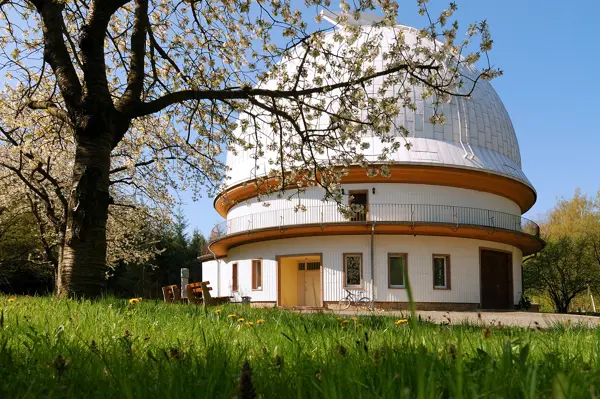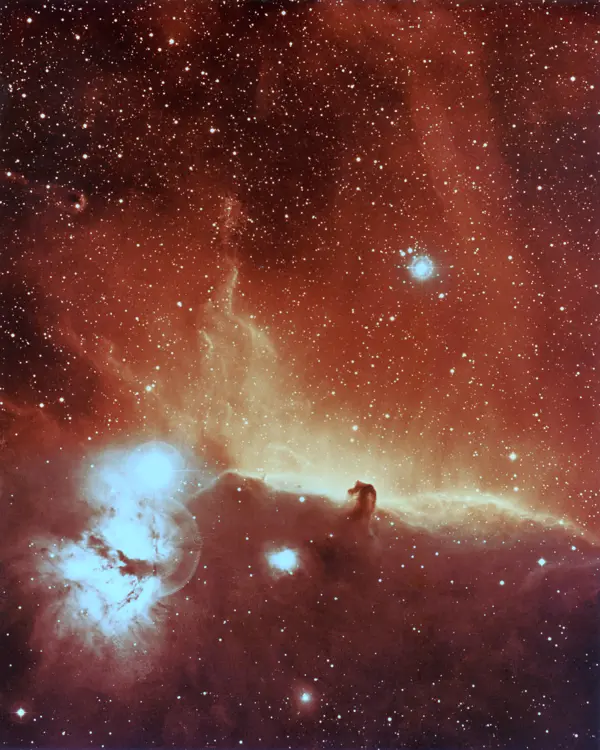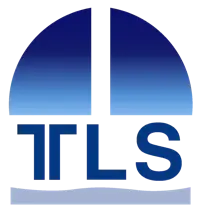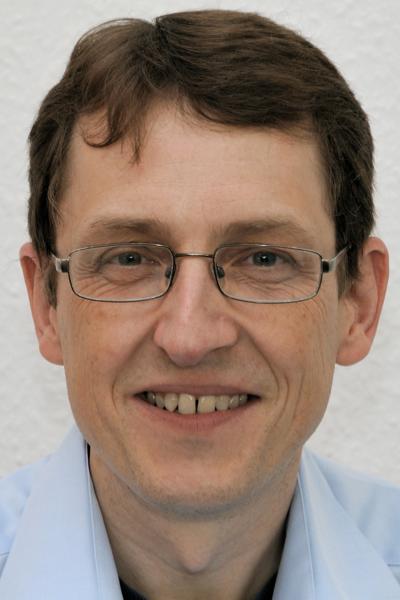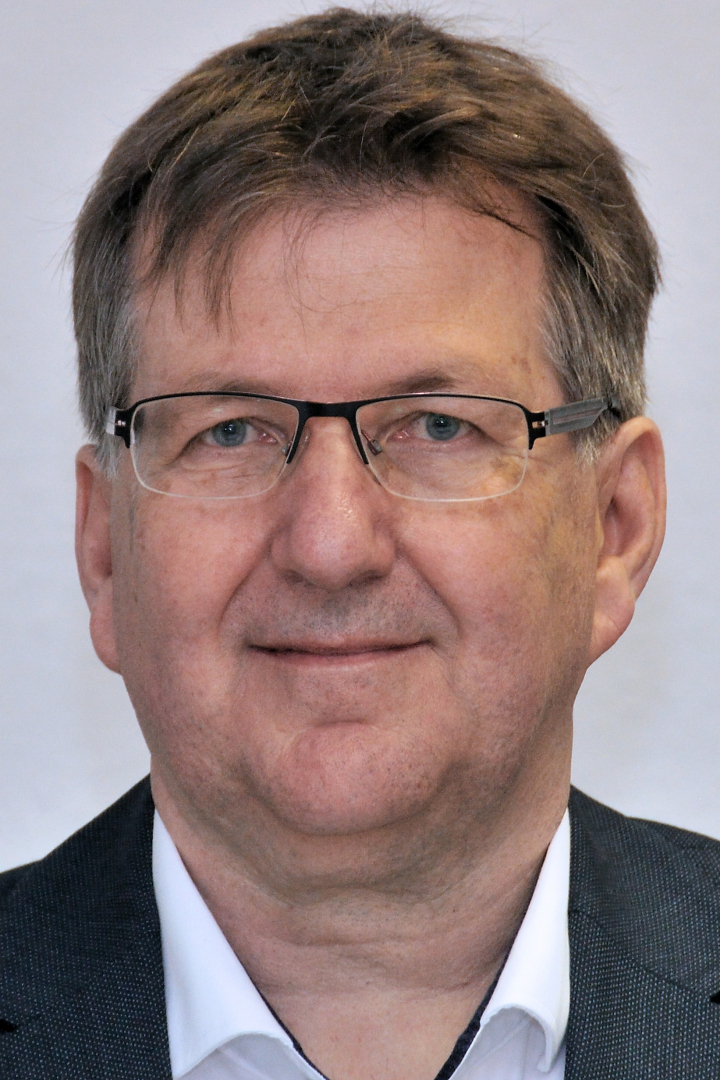The Thuringian State Observatory Tautenburg (TLS) is a research institute of the Free State of Thuringia. It conducts basic research in astrophysics. The astronomers
- search for and characterize extrasolar planets,
- observe and analyze solar and stellar oscillations,
- explore gamma-ray bursts,
- investigate the processes of star formation,
- examine the structure and evolution of the Milky Way and distant galaxies,
- and track asteroids.
TLS researchers use various telescopes for their observations: TLS astronomers observe at large telescopes worldwide. The centerpiece in Tautenburg is the 2-meter Alfred-Jensch Telescope for observation in the optical spectral range. The Thuringian State Observatory also operates a station of the European radio telescope Low Frequency Array (LOFAR).
The optical Alfred-Jensch Telescope is the largest Schmidt camera in the world. Due to its design, the Schmidt mirror has a very large field of view, allowing the 2-meter telescope of the Thuringian State Observatory to observe and photograph extensive celestial objects such as galaxies, nebulae, star clusters, and the orbits of asteroids well. As a universal telescope, it can be converted into a Coude telescope.
LOFAR is the world's largest radio telescope for receiving radio waves and ultrashort waves. The receiver stations are distributed across several countries in Europe: 38 stations are located at the headquarters in the Netherlands, six in Germany (one of them in Tautenburg), and others in France, Ireland, Latvia, Poland, Sweden, and the United Kingdom. Since January 2024, LOFAR is operated by a European Research Infrastructure Consortium (ERIC). The Thuringian State Observatory represents the German participants in the LOFAR ERIC.
In a modern solar laboratory, astronomers are developing instruments and a prototype for a solar observatory to continuously monitor the sun. Strong eruptions occur repeatedly on the sun, which hurl a lot of material into space. This material (plasma) can affect technological facilities in space and on Earth as a solar storm. For example, satellites for communication or navigation could fail or the power supply on Earth could be disrupted. The scientific investigation of solar activity is becoming increasingly urgent. For this reason, research into the interior of the sun and stars and their magnetic activity is being expanded as a field of research at the Thuringian State Observatory.
Currently, a total of 50 employees are employed at the Thuringian State Observatory, including 35 in the scientific field, including junior research groups and scientific assistants.
Latest News
-

Students from the Wilhelm-Ostwald-Gymnasium in Leipzig visit the Observatory in Tautenburg
- Information
- 25 June 2025
A group of 25 students from the Wilhelm-Ostwald-Gymnasium (WOG) in Leipzig, together with two teachers, visited the Thuringian State Observatory in June 2025. Visiting an astronomical research facility is a great addition to the content taught in their astronomy class. Wilhelm-Ostwald-Gymnasium is a... -

How a new Camera System provides a more detailed Look at the Sun
- Information
- 20 May 2025
A team of solar physicist, among them Markus Roth, director of the Thuringian State Observatory, got a more detailled view of active regions of the Sun. They used a modern camera system and managed to get high-resolution pictures of Sun spots. The pictures were taken at the Vacuum Tower Telescope at... -

Talks and Guided Tours - the Programme for the Open House
- Information
- 06 May 2025
The Thuringian State Observatory invites all astronomy fans to come visit during its Open House on Sunday, May 25th, 2025. Visitors can see the 2-meter Alfred Jensch telescope and the LOFAR radio telescope. The gates to the observatory grounds will be open from 10 am to 5 pm. Scientists will enterta... -

Reviewing extrasolar planets to find possible patterns
- Information
- 08 April 2025
The “Encyclopaedia of Exoplanetary Systems” currently lists 7.441 extrasolar planets (as of March 2025). With so many known extrasolar planets or planetary systems, astronomers try to find patterns why certain stars have planetary companions and how to characterize and group those planets. To help an...
Interesting Topics
Exoplanets
How unique is our solar system in our galaxy, the Milky Way? How are planets actually formed? How common are extrasolar planets? And what conditions must be present for life to arise on planets ? Astronomers at the Thuringian State Observatory have been studying ...Read more
Galaxies, Galaxy Clusters, Quasars
Since light travels at a finite speed, looking deep into space is also a look back into the history of the universe. In recent decades, it has become possible to look so deep into the universe that observations reveal cosmologically relevant developmental effects on large scales...Read more
2-m Universal Mirror Telescope
The centerpiece of the Tautenburg Observatory for optical spectral range observations is the 2-m Universal Mirror Telescope. When it was first commissioned, it was one of the five largest telescopes in the world. In 1992...Read more
History of TLS
The history of the observatory in the Tautenburg Forest begins shortly after the Second World War. It is influenced and shaped by the political events of the post-war period: the division of Germany. Find out more about the background and the exciting development of the institute.Read more
Team

Job Postings
Stellenausschreibung Informatiker (m/w/d)
05.06.2025
Die Thüringer Landessternwarte (TLS) ist eine Forschungseinrichtung des Landes Thüringen zur Durchführung auf Dauer angelegter Forschungsprogramme in den Bereichen der Astronomie, Astrophysik und Weltraumforschung. Die TLS betreibt das optische 2m-Alfred Jensch-Teleskop, eine internationale Station des Europäischen Radioteleskops LOFAR sowie ein Sonnenlabor und beteiligt sich weltweit an Instrumentierungsprojekten an Teleskopen. Das Institut liegt nahe der Universitätsstadt Jena im Tautenburger Forst.
An der Thüringer Landessternwarte ist zum 1. September 2025 eine Stelle als Informatiker (m/w/d) zu besetzen.
Ihre Aufgaben im Institut sind vielseitig und spannend – folgende Tätigkeiten erwarten Sie:
- Eigenverantwortliche Systemadministration eines Class-C-Netzes
- Eigenständige Betreuung der zentralen Server und seiner Dienste (Mail, DNS, DHCP, FTP, WWW)
- Betreuung, Wartung und Pflege der vorhandenen Computerhard- und Software des Institutes
- Anwenderunterstützung bei der Rechnernutzung
- Betreuung von Audio- und Videotechnik (Videokonferenzen)
- Technische Verwaltung und Betreuung der Institutshomepage
- Mitarbeit beim turnusmäßigen Umbau der optischen Systeme des 2 m - Teleskopes
- Interdisziplinäre Zusammenarbeit mit der Wissenschaft, den Werkstätten der TLS und mit anderen, auch internationalen astronomischen Instituten bei der Entwicklung, Erprobung undAnpassung technischer Komponenten.
Die vollständige Stellenausschreibung kann hier angesehen werden.

We stand for an open-minded Thuringia
The Thuringian State Observatory in Tautenburg is a research institution that promotes diversity and individuality based on respect and tolerance, and opposes anti-democratic and discriminatory tendencies. For this reason, we support the initiative "Weltoffenes Thüringen" (Open-minded Thuringia). The decentralized, networked initiative aims to send a signal that many people, institutions, associations, and companies in the state stand for a democratic, diverse, and open-minded Thuringia. For more information about "Weltoffenes Thüringen" and the opportunity to support the initiative, please visit: www.thueringen-weltoffen.de
Gallery
Our rights of use apply to these images.




